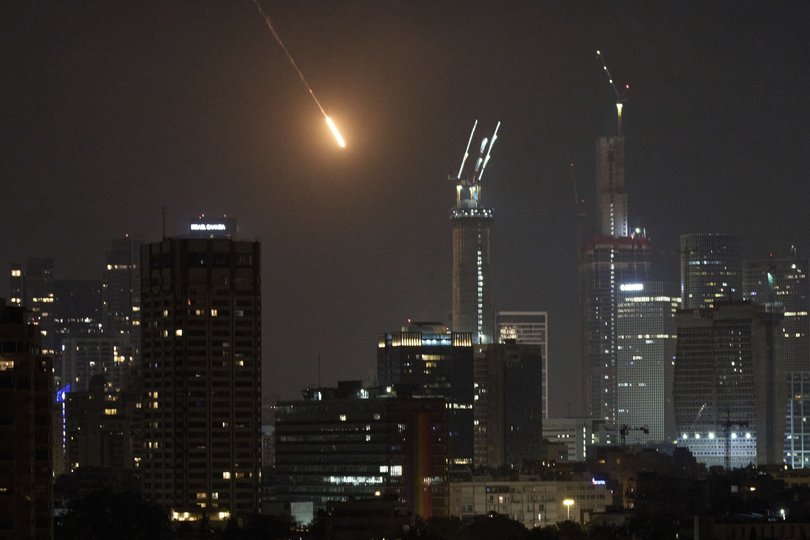Middle East crisis: How Israel exploited a weakness in Iran’s missile defences
Iran has long placed great importance on its missile arsenal, both to shoot down enemy fighter aircraft and threaten Israel and other foes across the Middle East.
As Israel planned for a surprise attack on Iran’s nuclear-weapon program, it found a weak point in those missile defences: a shortage of trucks.
To protect its arsenal from a pre-emptive attack, Iran stores missiles in bunkers. Trucks transport them to missile launchers.
Sign up to The Nightly's newsletters.
Get the first look at the digital newspaper, curated daily stories and breaking headlines delivered to your inbox.
By continuing you agree to our Terms and Privacy Policy.Mossad, Israel’s foreign intelligence agency, calculated that Iran had four times as many missiles as trucks, according to Israeli media outlet N12 and the Wall Street Journal, creating a transport bottleneck.
Israeli drones were shipped into Iran as commercial cargo. Mossad-trained operators waited near air-defence and missile bases. When the attack began, they used quadcopters carrying explosives to blow up dozens of trucks transporting missiles from storage to the launch sites, the Journal reported.
The attacks contributed to two important early victories for Israel: Iran’s relatively weak initial retaliation; and the Israeli Air Force’s freedom to operate over Iran seemingly unthreatened.
“Israeli Air Force aircraft are now able to fly over Tehran with minimal resistance,” Australian strategist and former general Mick Ryan wrote on Sunday.
“There are no verified reports of any Israeli aircraft being lost over Iran.”
‘Shock and awe’
In recent weeks the Iranian Air Force boasted that its defences were ready for an Israeli attack. But its fleet of 1970s-era F-14 Tomcats and MiG-29s do not appear to have even tried to resist the 200 American-made F-16 and F-35 fighters and other aircraft that have bombed their country since Friday.
The F-16s, which have been upgraded with Israeli technology, each carried eight GBU-39B Small Diameter Bombs, which can be launched 75km from their target.
The Israeli Air Force is so confident that on Saturday night or Sunday morning it blew up a Boeing 707 air refueller at a base near the Afghanistan border, some 2300km from Tel Aviv.
The Times of Israel reported it may have been the longest-range air strike in Israeli history, surpassing a 2000km attack on the Palestine Liberation Organisation in Tunisia in 1985.
Pro-Israeli analysts argue that dictatorships across the region, including Iranian adversary Saudi Arabia, are pleased Iran’s plans for nuclear weapons have been set back and intimidated by Israel’s military prowess.
Even Russia, which struck a strategic cooperation pact with Iran in January, offered a muted response to the attack on the country that provides it with weapons to use against Ukraine.
“It’s shock and awe,” a former Israeli military intelligence officer who specialised in Iran’s nuclear program, Ron Porat, told The Nightly. “Everyone is betting on the wining side.”

Interception rate
On Monday morning, a power plant in the Israeli port of Haifa was hit and was on fire, according to media reports.
Before the war, Israeli intelligence estimated Iran had about 2000 long-range ballistic missiles, according to Mr Ryan. Since Friday, Iran has launched 10 barrages at Israel.
An earlier tally put the number of missiles at 150 to 250. Israeli forces have intercepted about 92 per cent of the missiles, an Israeli official told Reuters.
The Iranian regime may have helped Israel locate a big missile depot by broadcasting a propaganda video of the armed forces chief of staff driving around one in a jeep.
Iran’s inability to defend its skies had serious consequences for Air Force chief Amir Ali Hajizadeh, who was killed in an underground bunker with the heads of Iran’s drone unit and air defence command, according to the Israel Defence Force.

Hitting the police
Israel’s first waves targeted missile and nuclear sites. The second hit its energy industry. A third on Sunday attacked forces used by the regime to control the 90 million people under its control.
CNN reported smoke coming from the Justice Ministry in Tehran on Sunday. The Foreign Affairs Ministry was also hit, along with the Ministry of Intelligence and Security and the Law Enforcement Command headquarters, which controls a national police force and riot squads.
“These internal security functions are particularly important given that recent Israeli strikes on Iranian energy infrastructure will likely worsen Iran’s ongoing energy crisis and lead to more widespread and frequent electricity shortages and outages,” analysts from the Institute for the Study of War wrote.
“Frustration over energy shortages could trigger internal unrest.”

